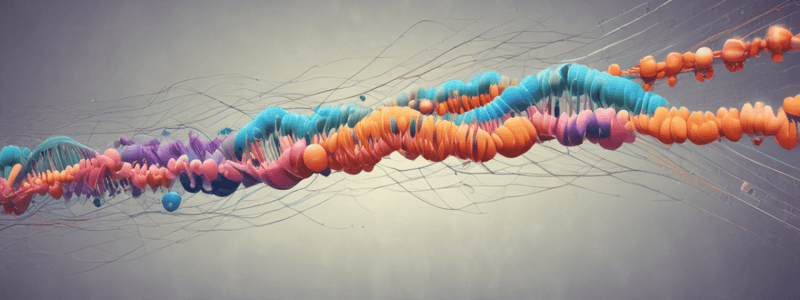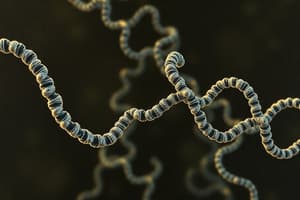Podcast
Questions and Answers
What is the primary function of the genome in an organism?
What is the primary function of the genome in an organism?
- To serve as a set of assembly instructions for cellular development (correct)
- To provide a blueprint for cellular structure
- To facilitate environmental adaptations in an organism
- To regulate the number of chromosomes in a cell
What is the primary difference between eukaryotic and prokaryotic chromosomes?
What is the primary difference between eukaryotic and prokaryotic chromosomes?
- Eukaryotic chromosomes are typically circular, while prokaryotic chromosomes are linear
- Eukaryotic chromosomes are smaller and more gene-dense, while prokaryotic chromosomes are larger and less gene-dense (correct)
- Eukaryotic chromosomes are composed of multiple chromosomes, while prokaryotic chromosomes are composed of a single chromosome
- Eukaryotic chromosomes are typically found in sex cells, while prokaryotic chromosomes are found in somatic cells
What is the term for the number of chromosomes in a cell?
What is the term for the number of chromosomes in a cell?
- Aneuploidy
- Genome
- Karyotype (correct)
- Ploidy
What is the term for having an incorrect number of chromosomes?
What is the term for having an incorrect number of chromosomes?
Which of the following organisms has a XY sex determination system?
Which of the following organisms has a XY sex determination system?
What is the term for the study of the structure and function of chromosomes?
What is the term for the study of the structure and function of chromosomes?
Which of the following organisms has temperature-dependent sex determination?
Which of the following organisms has temperature-dependent sex determination?
What is the term for the process by which an organism's sex is determined by environmental factors?
What is the term for the process by which an organism's sex is determined by environmental factors?
Which of the following organisms has a haploid-diploid life cycle?
Which of the following organisms has a haploid-diploid life cycle?
What is the ploidy of cultivated strawberries?
What is the ploidy of cultivated strawberries?
What is a characteristic of genes in viruses?
What is a characteristic of genes in viruses?
What is the primary mechanism used by the coconut cadang-cadang viroid to replicate itself?
What is the primary mechanism used by the coconut cadang-cadang viroid to replicate itself?
What is a characteristic of prokaryotic genomes?
What is a characteristic of prokaryotic genomes?
What is the term for the collection of all genes present in a whole ecosystem or environment?
What is the term for the collection of all genes present in a whole ecosystem or environment?
Why is it difficult to identify genes in humans?
Why is it difficult to identify genes in humans?
What is the purpose of the micronucleus in Paramecium?
What is the purpose of the micronucleus in Paramecium?
What is the characteristic of CpG islands in DNA?
What is the characteristic of CpG islands in DNA?
What is the size of the smallest known prokaryotic genome?
What is the size of the smallest known prokaryotic genome?
Why are humans a poor model organism for biomedical research?
Why are humans a poor model organism for biomedical research?
What is the primary reason for the confusion about gene numbers in humans?
What is the primary reason for the confusion about gene numbers in humans?
What is a distinct characteristic of prokaryotic chromosomes compared to eukaryotic chromosomes?
What is a distinct characteristic of prokaryotic chromosomes compared to eukaryotic chromosomes?
What is an example of a species that exhibits environmental sex determination?
What is an example of a species that exhibits environmental sex determination?
What is the term for the number of sets of chromosomes in a cell?
What is the term for the number of sets of chromosomes in a cell?
What is a characteristic of the sex chromosomes in birds and moths?
What is a characteristic of the sex chromosomes in birds and moths?
What is an example of an organism that has a haploid-diploid life cycle?
What is an example of an organism that has a haploid-diploid life cycle?
What is a characteristic of the genome compared to a blueprint?
What is a characteristic of the genome compared to a blueprint?
What is the ploidy of wild strawberries?
What is the ploidy of wild strawberries?
What is a characteristic of the sex chromosomes in platypuses?
What is a characteristic of the sex chromosomes in platypuses?
What is the term for having an incorrect number of chromosomes?
What is the term for having an incorrect number of chromosomes?
What is a characteristic of the sex determination system in some spiders?
What is a characteristic of the sex determination system in some spiders?
What is the characteristic that distinguishes the mitochondrial genome from the nuclear genome?
What is the characteristic that distinguishes the mitochondrial genome from the nuclear genome?
Which of the following statements is true about the arrangement of genes in eukaryotes?
Which of the following statements is true about the arrangement of genes in eukaryotes?
What is the primary challenge in identifying genes in humans?
What is the primary challenge in identifying genes in humans?
What is the characteristic of the genome of the Pandoravirus?
What is the characteristic of the genome of the Pandoravirus?
What is the term for the study of the genetic material present in a whole ecosystem or environment?
What is the term for the study of the genetic material present in a whole ecosystem or environment?
What is the characteristic of the haplodiploid system of sex determination?
What is the characteristic of the haplodiploid system of sex determination?
What is the characteristic of the coconut cadang-cadang viroid?
What is the characteristic of the coconut cadang-cadang viroid?
What is the characteristic of the sex determination system in some species of monkeys?
What is the characteristic of the sex determination system in some species of monkeys?
What is the characteristic of the genome of the muntjac deer?
What is the characteristic of the genome of the muntjac deer?
What is the characteristic of the mitochondrial Eve?
What is the characteristic of the mitochondrial Eve?
Study Notes
Haplodiploidy and Chromosome Types
- Bees, wasps, and ants are haplodiploid, with haploid males and diploid females.
- Different types of chromosomes are inherited differently: autosomal genes, Y-linked genes, X-linked genes, and mitochondrial genes.
Mitochondrial Eve
- Mitochondrial Eve was not the first woman, nor was she the only woman alive at the time, nor was she the only woman who left descendants.
- She was just our last common ancestor if you only consider the female line.
Viroids
- Viroids are small RNA molecules that do not code for any proteins but use the host's RNA polymerase to replicate themselves.
- The smallest known pathogen is the coconut cadang-cadang viroid, which is a 246bp RNA molecule that kills 1 million trees a year.
Viruses and Giant Viruses
- Viral genomes tend to be compact.
- Genes in viruses often overlap and are multifunctional.
- Typical virus genome sizes are in the tens of thousands of base pairs, but there are extremes: single-stranded DNA viruses can be less than 2Kb in length, and 3Mb Pandoraviruses, discovered in 2013, infect amoebas.
Prokaryotes
- Prokaryotes have generally compact, circular genomes.
- Genes are arranged into operons.
- Plasmids are 'optional extras'.
- There are extremes: N. deltocephalinicola has the smallest prokaryotic genome at 112Kb, and S. hofmanni has the largest prokaryotic genome at 12Mb.
Eukaryotes
- Eukaryotes have typically large genomes organized into chromosomes.
- Organelles like mitochondria and chloroplasts can have genomes separate from the nuclear genome.
- Nobody has much of an idea what causes evolution/variation in chromosome number; it's an unsolved mystery.
- Within mammals, one of the monkeys has the most chromosomes at 97, and the muntjac deer has the fewest at 4.
Protists
- Protists are an extremely diverse group of unicellular eukaryotes.
- Some protists, like Paramecium, have two kinds of cell nuclei: one 'working memory' (macronucleus) containing many thousands of tiny, gene-sized 'chromosomes', and one 'master copy' micro nucleus containing the germline genome.
Human Genomes
- Humans are a terrible model organism due to long generation time, small litter sizes, and huge ethical problems with experimentation.
- The understanding of the human genome has been pieced together from various sources, including pedigrees and other genomes.
Gene Numbers
- In bacteria, identifying genes is relatively straightforward.
- In humans, it's not, because genes are hidden among a lot more junk.
- There are also large introns, splice sites, and alternative splicing patterns.
- ORFs can be found bioinformatically, but a very short ORF is unlikely to be transcribed.
- Homology with known genes from other species can also be used to help find genes.
Chromosome Structure
- Eukaryotic chromosome can be a sex chromosome or an autosome.
- Prokaryotic chromosome is typically circular, more gene-dense, and much smaller.
- One way the genome can be structured is that there can be sex chromosomes, which are subject to very different evolutionary pressures from autosomes.
Sex Determination
- XY systems like mammals have are not the only way to do it.
- Platypuses have ten sex chromosomes, and birds have a WZ system, as do moths.
- Some spiders have an X1X20 system with males heterogametic, and nematodes have an XO system where the female has more chromosomes than the male.
- Sex chromosomes aren't the only way to do sex determination; clownfish start male and turn female when they come to dominate a group, and alligators and crocodiles have temperature-dependent sex determination.
Studying That Suits You
Use AI to generate personalized quizzes and flashcards to suit your learning preferences.
Description
Explore the concept of the genome, its structure, and different types of chromosomes. Learn about the differences between eukaryotic and prokaryotic chromosomes, and how sex chromosomes are subject to unique evolutionary pressures.




